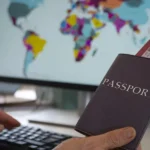
By, Gokite Tour
- 1.1k Views
- 6 Min Read
- (0) Comment
Different Types of Peru Travel Visas Explained
Planning a trip to Peru—a land of ancient wonders, vibrant culture, and breathtaking landscapes—requires understanding the country’s visa policies. Whether you’re visiting to explore Machu Picchu, savour the culinary delights of Lima, or trek the Sacred Valley, it’s essential to know which travel visa best suits your purpose. Navigating Peru’s visa system can seem overwhelming at first, especially with the variety Types of Peru Travel Visas available for different travellers and their needs.
This detailed guide will help clarify the Types of Peru Travel Visas, ensuring you’re well-prepared before your journey. You will also learn which Peru visa is easiest to get, what documentation you’ll need, and most importantly, how many visa types are there in the Peru. Let’s explore the visa options available to make your Peruvian adventure as smooth and hassle-free as possible.
1. Tourist Visa
One of the most common Types of Travel Visa to Peru is the Tourist Visa, ideal for individuals visiting Peru for leisure, sightseeing, or visiting friends and family. It is usually granted for up to 183 days (about six months), though typically issued for 90 days initially.
For citizens of certain countries, Peru allows visa-free entry, while others must apply at their nearest Peruvian consulate. The Tourist Visa does not allow the holder to engage in paid work or business activities. In terms of simplicity, the Tourist Visa ranks high—answering your query on which Peru travel visa is easiest to get—especially for applicants from countries with strong diplomatic relations with Peru.
2. Business Visa
The Business Visa is another frequently issued Types of Peru Travel Visas designed for individuals engaging in business activities, attending meetings, conferences, or signing contracts. Like the Tourist Visa, it is also generally issued for up to 90 days, with the possibility of extension.
While this visa allows for business-related activities, it does not authorize full-time employment within Peru. The process is relatively straightforward for applicants with appropriate business documentation, making it another viable answer to which Peru visa is easiest to get, especially for those with strong corporate ties.
3. Student Visa
For those pursuing academic opportunities in Peru, the Student Visa is the perfect choice. Whether you’re attending a university, language school, or participating in an exchange program, this visa covers educational stays.
Typically issued for the duration of the course, the Student Visa may be extended and allows limited part-time work under certain conditions. While it requires additional paperwork, it is still among the commonly issued visas, contributing to the overall list when considering how many visa types are there in the Peru.
4. Work Visa
The Work Visa (also known as the Resident Worker Visa) is intended for individuals employed by a Peruvian company or organisation. This visa requires a valid employment contract approved by Peruvian authorities and is initially granted for one year, renewable annually.
As it involves securing local employment and satisfying stricter requirements, it is not considered among which Peru visa is easiest to get. However, it is essential for those looking to build a long-term career in Peru.
5. Family Visa
Also referred to as the Family Unity Visa, this option allows foreign nationals to live in Peru with family members who are Peruvian citizens or legal residents. This is a residency visa and typically involves providing ample documentation to prove the family relationship.
In terms of processing, it is neither the hardest nor the easiest Peru visa to get, but it plays a crucial role in family reunification, contributing to how many visa types are there in the Peru.
6. Retirement Visa
For retirees looking to settle in Peru, the Retirement Visa (Rentista Visa) is an excellent choice. Applicants must show proof of sufficient income, typically a pension or other stable financial resources, to support themselves without working in Peru.
This visa grants residency and is relatively straightforward for qualified applicants, making it an attractive option for foreign retirees and a notable mention when counting how many visa types are there in the Peru.
7. Journalist Visa
The Journalist Visa is granted to professional journalists and media representatives covering events in Peru. Typically issued for short-term assignments, this visa requires approval from Peru’s Ministry of Foreign Affairs.
Due to its niche nature, it is not the easiest Peru visa to get, but essential for foreign media professionals working in the country.
8. Religious Visa
Individuals engaged in religious missions or activities can apply for the Religious Visa. Sponsored by religious organisations recognized in Peru, this visa permits extended stays for religious work.
Like the Journalist Visa, it requires institutional support, making it more specialised among the Types of Peru Travel Visas.
9. Exchange and Cultural Visa
For those participating in exchange programs, internships, or cultural activities, the Exchange and Cultural Visa is the ideal option. Issued based on program approval and sponsorship, this visa enables temporary residence in Peru for educational or cultural purposes.
Conclusion
Understanding the Types of Travel Visa to Peru is essential for planning your journey and ensuring a smooth entry into this fascinating country. Whether you are visiting for leisure, business, education, or retirement, there is a visa type designed to meet your specific needs. Knowing how many visa types are there in the Peru gives you a clear picture of the available options and helps you select the most appropriate one.
Among all options, if you are wondering which Peru visa is easiest to get, the Tourist Visa remains the most accessible for many travellers. Proper planning and documentation are key to a successful visa application, paving the way for a memorable experience in Peru. Ready to start your Peruvian adventure? Make sure to apply for the right visa today!
FAQs
Q1: How many visa types are there in the Peru?
There are at least nine common visa categories including Tourist, Business, Student, Work, Family, Retirement, Journalist, Religious, and Exchange/Cultural Visas. The exact number may vary depending on sub-categories and evolving regulations.
Q2: Which Peru visa is easiest to get?
The Tourist Visa is generally considered the easiest Peru visa to get, especially for citizens from countries with visa-exempt status or those eligible for e-visas.
Q3: Can I work in Peru on a Tourist Visa?
No. The Tourist Visa does not permit employment or any income-generating activities in Peru.
Q4: How long can I stay in Peru on a Tourist Visa?
Most Tourist Visas are valid for 90 days, with the possibility of an extension up to 183 days.
Q5: Can I extend my visa in Peru?
Some visa types, such as Tourist and Business Visas, may be extended under certain conditions. However, extension policies can change, so it is advisable to check the latest guidelines from Peruvian immigration authorities.
Most Popular International Visas for Omanis
Albania Visa | Argentina Visa | Australia Visa | Austria Visa | Azerbaijan visa | Bahamas Visa | Bahrain visa | Bangladesh visa | Bosnia Visa | Brazil Visa | Brunei Visa | Cambodia visa | Cameroon visa | Canada Visa | Chile visa | China Visa | Colombia Visa | Croatia Visa | Cyprus visa | Czech republic visa
How to Apply visa for other countries
Denmark visa | Egypt visa | Ethiopia Visa | France visa | Germany visa | Greece visa | Hong Kong Visa | Hungary visa | India visa | Indonesia Visa | Ireland visa | Italy Visa | Japan visa | Jordan visa | Kazakhstan visa | Kenya visa | Kuwait Visa | Madagascar visa | Malaysia visa | Malta Visa
Recommended Read: Complete Visa Information for Peru Travellers





Leave a comment:
You must be logged in to post a comment.